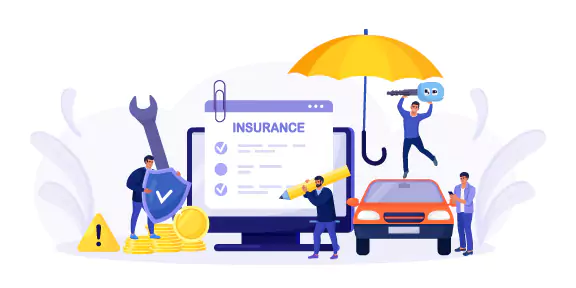When it comes to auto insurance, there can be so many myths and misconceptions. These myths can lead drivers to make decisions that can result in not having enough coverage, higher costs, and unnecessary risks.
Here we’ll address some of the most common auto insurance myths and give the realities of car insurance, ensuring that you’re well-informed when it comes to your insurance policies.
1. Myth: Red Cars Cost More to Insure
One of the most common car insurance myths is the belief that red cars cost more to insure and are more likely to be pulled over by law enforcement.
The truth is that insurance companies do not factor in the color of your car when determining your insurance premium, nor is there any evidence to support the idea that red cars are more likely to be pulled over. Instead, insurance companies focus on the car’s make, model, year, and overall safety record when calculating your rate.
2. Myth: Full Coverage Means Everything is Covered
The term “full coverage” is often misunderstood. A lot of drivers assume that this type of coverage means their insurance will cover everything, but that’s not the case. It usually includes both comprehensive and collision coverage, but it doesn’t cover everything. For example, this type of coverage won’t pay for medical expenses injury protection unless those are specified in your policy. Understanding the limits of full coverage is crucial to ensuring you have enough coverage for your needs.
3. Myth: Comprehensive Insurance Covers Everything
Comprehensive insurance is another misunderstood aspect of auto insurance that is also often mixed up with full coverage. While comprehensive coverage protects against non-collision-related incidents like theft, vandalism, and natural disasters, it doesn’t cover everything. For instance, comprehensive coverage does not include collision damages, which are covered by collision coverage.
4. Myth: Your Personal Auto Insurance Covers Business Use
A common misconception is that your personal auto insurance covers business use, but this is not the case. These policies generally do not extend to business-related activities.
If you’re self-employed or use your vehicle for work purposes, you may need to purchase a separate business vehicle insurance policy. This specialized insurance is designed to cover the specific risks associated with business use, ensuring you’re protected and minimizing out-of-pocket costs in case of an accident. It’s important to understand that this is distinct from personal auto insurance; the latter typically does not cover business-related incidents, leaving you vulnerable to significant liability.
5. Myth: Only the Minimum Coverage is Necessary
Many drivers believe that only the minimum amount of auto liability insurance required by law is enough. While meeting the legal requirements is necessary, carrying only the minimum coverage can leave you vulnerable to significant out-of-pocket costs in the event of a serious accident. Liability insurance, which covers bodily injury protection and property damage, is important, but it’s also important to assess whether the minimum coverage limits are enough for your specific situation.
6. Myth: A Car’s Sticker Price Determines Insurance Costs
Another common misconception is that mid-priced cars are always cheaper to insure than luxury cars. While the car’s sticker price is a factor in determining insurance costs, it’s not the only one. Insurance companies also consider the car’s safety features, repair costs, overall safety record, and even the likelihood of theft. Sometimes, a more expensive car with excellent safety features can have lower insurance rates than a cheaper car that lacks those features.
7. Myth: Your Driving Record Doesn’t Affect Your Insurance Rate
Your record plays a significant role in determining your car insurance rate. Insurance companies assess your risk level based on your driving history. A clean driving record can result in lower insurance rates and many car insurance companies offer discounts to safe drivers while a history of accidents or traffic violations can lead to higher premiums. It’s important to maintain a good record to keep your insurance costs in check.

8. Myth: Auto Insurance Companies Don’t Consider Your Credit History
Your credit history can influence your insurance premium. Many providers use a credit-based insurance score to assess the risk of insuring you. A poor credit history can result in higher premiums, while a good credit score can lead to discounts. Maintaining a healthy credit history is not only important for your financial affairs but also for securing affordable auto insurance.
9. Myth: Health Insurance Covers All Injuries from a Car Accident
While health insurance may cover some medical expenses resulting from a car accident, it doesn’t cover everything. Personal injury protection (PIP) or medical coverage under your auto insurance policy is designed to cover medical expenses that it might not fully address. Relying solely on health insurance could result in significant out-of-pocket expenses.
10. Myth: Insurance Costs More for Older Drivers
There’s a common belief that older drivers always pay more for car insurance. While age can be a factor, it’s not the sole determinant. Experienced older drivers with a clean driving history may pay less than younger, less experienced drivers. Insurance companies consider several factors, including driving experience, overall safety record, and vehicle type, when determining insurance rates.
11. Myth: Insurance Covers Everything When You’re at Fault
If you’re at fault in an accident, your insurance will cover certain damages, but not everything. Auto liability insurance required by law will cover the other party’s damages up to your policy’s limits. However, your damages may not be fully covered unless you have the appropriate collision coverage or physical damage coverage. Understanding what your insurance covers and what it doesn’t is vital for avoiding unexpected expenses.
12. Myth: You Don’t Need Full Coverage for an Older Car
Some drivers believe that they don’t need full coverage for an older car. While it’s true that the value of an older car may not justify the cost of comprehensive and collision coverages, it’s essential to assess your specific situation. If your car is still valuable or you can’t afford to replace it out of pocket, maintaining full coverage could be a wise decision.
13. Myth: Insurance Rates Are Set in Stone
Insurance rates are not set in stone. They can change over time based on several factors, including your driving history, credit history, and even changes in the insurance industry. Regularly reviewing your insurance policy and shopping around for better rates can help you find more affordable coverage.
14. Myth: All Insurance Providers Are the Same
Not all insurance providers are the same. Different companies offer different coverage options, customer service levels, and pricing. It’s essential to compare insurance companies to find the one that best meets your needs. Working with a reputable insurance company that offers the right combination of coverage, service, and price can make all the difference in your overall satisfaction with your insurance policy.
Avoid These 14 Auto Insurance Myths
Auto insurance is a complex and often misunderstood subject. By debunking these common car insurance myths, you can make more informed decisions about your coverage and ensure that you’re adequately protected.
Whether you’re considering personal auto insurance, business vehicle insurance, or assessing your current auto insurance policy, understanding the realities of insurance can help you avoid costly mistakes and ensure you have the right coverage for your needs.
Ready to start your search? >>> The Ultimate Guide to the Best Car Insurance Comparison Sites for 2024

